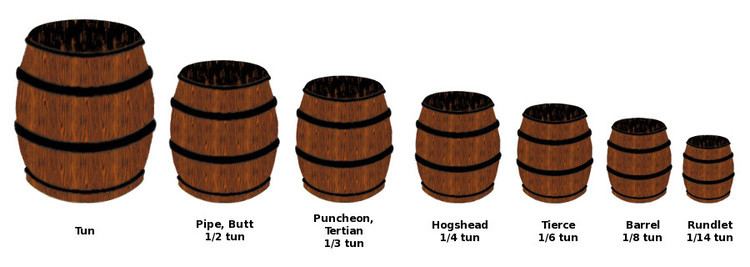 | ||
Capacities of wine casks were formerly measured and standardised according to a specific system of English units. The various units were historically defined in terms of the wine gallon so varied according to the definition of the gallon until the adoption of the Queen Anne wine gallon in 1707. In the United Kingdom and its colonies the units were redefined with the introduction of the imperial system whilst the Queen Anne wine gallon was adopted as the standard US liquid gallon.
Contents
The major wine producing countries use barrels extensively and have developed standards at variance with the traditional English volumes are commonly used in the wine and wine cooperage industries. Examples include a hogshead of 300 L (66 imp gal; 79 US gal), a barrique of 220 L (48 imp gal; 58 US gal) (Bordeaux), a barrel of 225 L (49 imp gal; 59 US gal) (Australia), a barrel of 230 L (51 imp gal; 61 US gal) (Burgundy) and a puncheon of 465 L (102 imp gal; 123 US gal).
Casks
The tun (Old English: tunne, Latin: tunellus, Middle Latin: tunna) is an English unit of liquid volume (not weight), used for measuring wine, oil or honey. Typically a large vat or vessel, most often holding 252 wine gallons, but occasionally other sizes (e.g. 256, 240 and 208 gallons) were also used.
In one example from 1507, a tun is defined as 240 gallons.
Early Modern English: "He that ys a gawner owght to understonde there ys in a tunne lx systerns and every systern ys iiii galons be yt wyne or oylle."
Translation: "He that is a gauger ought to understand that there is in a tunne 60 sesters, and every sester is 4 gallons, be it wine or oil."
The butt (from the mediæval French and Italian botte) or pipe was half a tun, or 1008 pints. Tradition has it that George, Duke of Clarence, the brother of Edward IV of England, was drowned in a butt of malmsey on 18 February 1478. (However, Josephine Tey in The Daughter of Time suggests that "drowned in a butt of malmsey" means rather that George, Duke of Clarence, drank himself to death rather than literally drowning in a container of wine.) In Edgar Allan Poe's short story "The Cask of Amontillado", the narrator claims he has received "a pipe of what passes for Amontillado". In Edward Bulwer-Lytton's novel "Paul Clifford", Lord Mauleverer states to Lawyer William Brandon "Because he sent me, in the handsomest manner possible, a pipe of that wonderful Madeira, which you know I consider the chief grace of my cellars, and he gave up a canal navigation bill, which would have enriched his whole county, when he knew that it would injure my property."
The puncheon was a third of a tun. The term puncheon, shortened to pon in the United States, is thought to derive from the fact that it would have been marked by use of a punch to denote its contents. The unit was also known as a tertian (from the Latin word for "third").
Of comparable size to the beer hogshead, the wine hogshead was equal to half a butt or a quarter of a tun.
Closely related to the modern oil barrel, the tierce was half a puncheon, a third of a butt or a sixth of a tun.
The wine barrel was half a wine hogshead or an eighth of a tun.
The rundlet was a seventh of a butt or a fourteenth of a tun.
History
Originally, the tun was defined as 256 wine gallons; this is the basis for the name of the quarter of 64 corn gallons. At some time before the 15th century, it was reduced to 252 gallons, so as to be evenly divisible by other small integers, including seven. Note that a 252-gallon tun of wine has an approximate mass of one long ton.
With the adoption of the Queen Anne wine gallon of 231 cubic inches the tun approximated the volume of a cylinder with both diameter and height of 42 inches. These were adopted as the standard US liquid gallon and tun.
When the imperial system was introduced the tun was redefined in the UK and colonies as 210 imperial gallons. The imperial tun remained evenly divisible by small integers. There was also little change in the actual value the tun.
